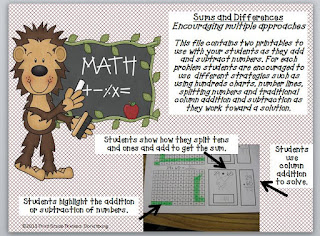I was flipping through a booklet on Guided Math that I got from a great conference I attended last spring. There was a page of statements for students to consider as they assessed their own progress. The page was entitled:
Evidence That I'm Growing as a Mathematician
a. I support my conclusions with valid mathematical reasoning.
b. I give more than one solution and/or more than one approach to problems.
c. My explanations show careful reasoning and deep thinking.
d. I use models and methods from class to solve problems.
e. I make connections among different ideas in math.
f. My explanations show that I am constructing deeper and broader understandings of math concepts.
g. I make and test conjectures about ideas and methods.
I must say it made me feel better to read this list. No where does it say: "I score in the nintieth percentile on a standardized test". HAH... Perhaps we can assume they would do well if they can show evidence of statements a-g but it is refreshing not to have it as an assessment criteria.
We have been working incredibly hard to provide problem solving opportunities that focus on skills and strategies that students construct and discuss. Much attention is being placed on the process of solving the problem rather than the answer itself. Most students have made great strides and are showing strong evidence that they are indeed growing as mathematicians. I especially appreciate the verb choice "growing" because it implies that they are not expected to have evolved into an expert yet and that it is OK to still be in the process of developing their skills.


I must say that running small guided math groups just feels good to me. Gone is the frustration felt when as a teacher you look around and know that you have lost the attention of far too many students. I've taken a simplistic approach to running this system. My students are either having Teacher Time, On My Own Time, or Partner Practice Time. This Target pocket chart helps to keep students and teacher on track. I spend about 15-20 minutes with each group so that I have face time with all students in small groups for 3-4 days a week.
 The On My Own Groups have enjoyed working with the IPads lately. We have a good program that allows students to practice their basic facts. It allows students to choose a level of difficulty to work with and then times their speed in solving basic addition/subtraction facts. They slide the sums over to the puzzle and if correct, it reveals part of the puzzle. Students were totally silent and engaged the entire time I met with my small group. Love using the IPads!
The On My Own Groups have enjoyed working with the IPads lately. We have a good program that allows students to practice their basic facts. It allows students to choose a level of difficulty to work with and then times their speed in solving basic addition/subtraction facts. They slide the sums over to the puzzle and if correct, it reveals part of the puzzle. Students were totally silent and engaged the entire time I met with my small group. Love using the IPads!
Meanwhile, my small groups have been exploring our "Big Idea". That idea being that we can use multiple strategies or approaches when solving for sums or differences. Running the small groups has allowed me to use manipulatives with those students who still need and benefit from them. Here we are using base ten blocks. We glued magnets to some of our sets so we could manipulate them on metal surfaces like these inexpensive cookie sheets.
We use these mats a lot when working through math problems. Here you can see how the students were drawing out partial hundreds charts to arrive at the sum. Another strategy used here was splitting numbers into ones and tens.
Look at this child showing evidence that she is growing as a mathematician: Showing multiple approaches to solving one problem. Here she used a partial hundreds chart, drew a number line and split the numbers. Awesome!
Allowing students time to share their thinking in these small groups has done wonders in helping them grow and learn.
Here is a small but FREE file that I've posted onto TPT. It has two of the open ended strategy sheets we have used recently. You can plug any two digit numbers in and student can use the different approaches to arrive at the same answer. It is a great way to have them check their thinking.
Head here if you are interested:
I'm in the process of filing other packets onto TPT so check back!
Comments? Thoughts? Email Me!! I love to hear from you!
youngdor8@gmail.com









 youngdor8@gmail.com
youngdor8@gmail.com



















